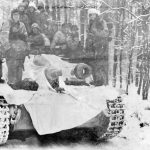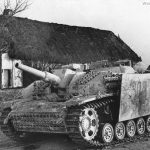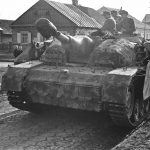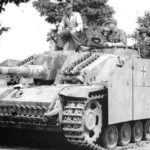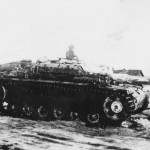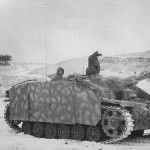StuH 42 winter 45
StuH 42 Ukraine 44
Frontal view
StuH 42 Ausf G 307
StuH 42 Italy
StuH 42 3
StuH 42 4
StuH 42 207
Upper hull with concrete armor
StuH 42 September 1943, Eastern Front
Sturmhaubitze 42 without muzzle brake
Loading ammunition into StuH 42
German StuH 42 number 131, July 1944 Finland
StuH 42 fitted with Schürzen
StuH 42 with zimmerit coating Finland, July 1944
German assault howitzer StuH 42
StuH 42 Finland, July 1944
StuH 42 winter
Sturmhaubitze 42 StuH 42 with schurzen crew
StuH 42 with saukopfblende schurzen winter
Destroyed StuH 42 winter
Camouflaged Sturmhaubitze StuH 42 II with zimmerit
StuH 42 was variant of the StuG III Ausf G was designed with a 105 mm howitzer (10,5cm Sturmhaubitze 42 L/28 variant of the 10,5 cm leFH 18) instead of the 7.5 cm StuK 40 L/43 cannon.
In response of the demand for a new artillery support vehicle for infantry, at the end of 1941 the Altmaerkische Kettenwerk GmbH (Alkett) was assigned to develop a 105 mm caliber L/28 howitzer-armed self-propelled assault gun on the Sturmgeschütz III chassis (Sd.Kfz. 142). The first copy was produced on Sturmgeschütz III Ausf. E chassis and was equipped with 10.5 cm howitzer leFH 18 L/28. Hitler was impressed with the new self-propelled weapon and ordered it into serial production. Before the end of 1942, 9 vehicles were produced, which were named Sturmhaubitze 42 (StuH 42).After the successful results of the field trials, it was decided to put the vehicle into serial production, which began in February 1943. In total, till the end of the war, around 1300 Sturmhaubitze 42 were built, with only minor changes during the production: different gun mantlet and resignation of muzzle brake in later series. The rest of the changes to the vehicle were identical to those made to its parallel produced peer, the Sturmgeschütz III Ausf. E.
The barrel of the 10.5 cm StuH 42 L/28 howitzer mounted in the Sturmhaubitze was shorter, thicker, and tapered more towards the exit than the 7.5 cm StuK 40 L/48 cannon from the StuG. The ammunition had to be loaded separately, as was usual with howitzers. This reduced the rate of fire to three to five rounds/min. The maximum firing range, which in practice did not play a role in direct fire, was 5,400 meters. Normally, targets on the battlefield were no further than 2,000 meters away. Compared to the StuG III, the StuH 42 could deliver a much larger quantity of high explosives to the target with its cannon. The 10.5-cm field howitzer grenade weighed 15.55 kg (1.4 to 1.75 kg of explosives), while the 7.5-cm Sprenggranate 40 weighed only 5.74 kg (0.68 kg of explosives). Effective fragments flew up to 35 meters to the sides and 10 meters forward. In addition to 26 explosive shells, a combat load of the StuH 42 also contained 10 hollow-charge HL/B or HL/C anti-tank projectiles. These could penetrate 90 or 100 mm of armor steel, depending on the model, regardless of the range.
